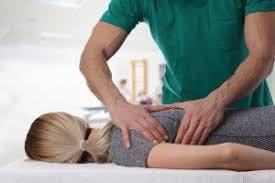Manual therapy
It is a technique where a physiotherapist uses their hands to manipulate, mobilize and massage the body tissues, a treatment technique used to manage musculoskeletal dysfunction. It includes assessment and treatment of neurological, cardio-respiratory and orthopedic problems through the use of hands-on techniques like manipulation and mobilization.
These techniques are used to
- Reduce pain
- Increase range of motion
- Reduce or eliminate inflammation and facilitate the ease of movement.
Physical therapists focus on the nerves, soft tissues and connective tissue (fascia), and/or on enhancing joint movement beyond its range of motion with the use of high velocity, low amplitude force.

Procedure
It is hands-on treatment, provided by the physical therapist. Treatment includes moving joints in specific directions and at different speeds to
- regain movement
- muscle stretching
- passive movements of the affected body part
- Moving patients body part against the therapist’s resistance to improve muscle activation and timing.
- Selected specific soft tissue techniques may also be used to improve the mobility and function of tissue and muscles.
Manual therapy uses no devices or machines. Instead, therapists use only their hands while performing skilled, specific hands-on techniques. When performing soft tissue work, therapists apply pressure to the soft tissues of the body, such as the muscles. This pressure can help relax muscles, increase circulation, break up scar tissue, and reduce or eliminate soft tissue inflammation. With manual therapy, clinicians also commonly mobilize and manipulate joints.
Benefits
- Decreased Pain: The goal for manual therapy is that any pain the patient is experiencing will be alleviated and eventually eliminated.
- Increased Performance: Using manual therapy in conjunction with training and exercise can help athletes improve their overall performance.
- Increased Range of Motion: Manual therapy can eliminate pain and increase the range of motion which is especially important for those who are experiencing a diminished ability to move due to pain.
- Muscle spasms and Muscle tension: Muscle spasm and Muscle tension may be alleviated completely by manual therapy
- Others: Neck pain and injuries; Hip, knee, ankle and foot problems; Hand, wrist, elbow and shoulder problems; Injuries caused by accidents
- Work related injuries
Disadvantages
The disadvantages of physical therapy, rehabilitation, and sports medicine are that these approaches require multiple weekly appointments, the treatment sessions are long, the cost of treatment is high, and patients can develop an unintended reliance on treatment.
When treatment guidelines are being assessed, these therapies often receive high appropriateness ratings, but one study did find that receiving physical therapy was associated with longer periods of pain.
Risks
The risk of major adverse events with manual therapy is low, but around half of manual therapy patients may experience minor to moderate adverse events after treatment.
The relative risk of adverse events appears greater with drug therapy but less with usual care.
DISCLAIMER
This web page provides general information and discussions about health, medicine and related subjects. The information and other content provided on this website, or in any linked materials, are not intended and should not be construed as medical advice, nor is the information a substitute for professional medical expertise or treatment.
The content is for information purpose only and is not a medical advice. Qualified doctors have gathered information from reputable sources; however Credence Medicure Corporation is not responsible for errors or omissions in reporting or explanations. No individual should use the information, resources and tools contained herein to self diagnose or self treat any medical condition.
If you or any other person has a medical concern, you should consult with your health care provider or seek other professional medical treatment. Never disregard professional medical advice or delay in seeking it because of something that have read on this blog or in any linked materials. If you think you may have a medical emergency, call your doctor or emergency services immediately.
The opinions and views expressed on this blog and website have no relation to those of any academic, hospital, health practice or other institution. Credence Medicure Corporation gives no assurance or warranty regarding the accuracy, timeliness or applicability of the content.
